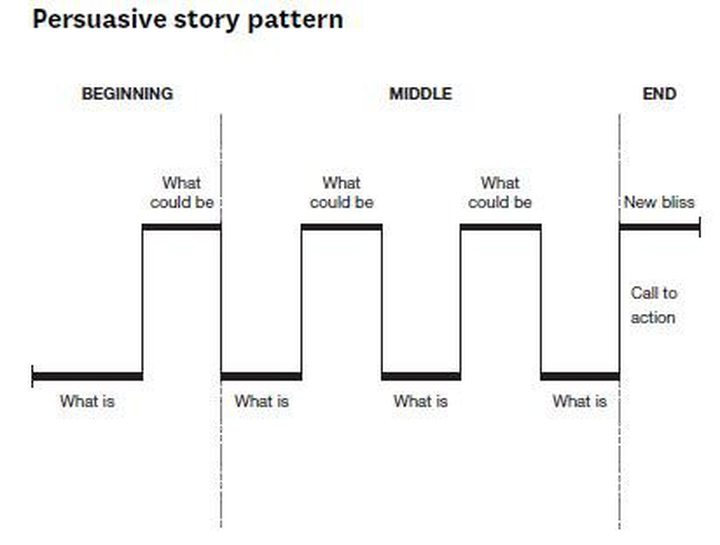Structure Your Presentation Like a Story

That tension helps them persuade the audience to adopt a new mindset or behave differently — to move from what is to what could be. And by following Aristotle's three-part story structure (beginning, middle, end), they create a message that's easy to digest, remember, and retell.
How it looks when you chart it out (see photo at the beginning)
And here's how to do it in your own presentations.
Craft the Beginning
Start by describing life as the audience knows it. People should be nodding their heads in recognition because you're articulating what they already understand. This creates a bond between you and them, and opens them up to hear your ideas for change.
After you set that baseline of what is, introduce your vision of what could be. The gap between the two will throw the audience a bit off balance, and that's a good thing — it jars them out of complacency. For instance:
What is: We fell short of our Q3 financial goals partly because we're understaffed and everyone's spread too thin.
What could be: But what if we could solve the worst of our problems by bringing in a couple of powerhouse clients? Well, we can.
Once you establish that gap, use the rest of the presentation to bridge it
Develop the Middle
Now that people in your audience realize their world is off-kilter, keep playing up the contrast between what is and what could be.
Let's go back to that Q3 update. Revenues are down, but you want to motivate employees to make up for it. Here's one way you could structure the middle of your presentation:
What is: We missed our Q3 forecast by 15%.
What could be: Q4 numbers must be strong for us to pay out bonuses.
What is: We have six new clients on our roster.
What could be: Two of them have the potential to bring in more revenue than our best clients do now.
What is: The new clients will require extensive retooling in manufacturing.
What could be: We'll be bringing in experts from Germany to help.
As you move back and forth between what is and what could be, the audience will find the latter more and more alluring.
Make the Ending Powerful
You don't want to end with a burdensome list of to-dos. Definitely include a call to action — but make it inspiring so people will want to act. Describe what I call the new bliss: how much better their world will be when they adopt your ideas.
So if you're wrapping up that Q3 update from above, you might approach it this way:
Call to action: It will take extra work from all departments to make Q4 numbers, but we can deliver products to our important new clients on time and with no errors.
New bliss: I know everyone's running on fumes — but hang in there. This is our chance to pull together like a championship team, and things will get easier if we make this work. The reward if we meet our Q4 targets? Bonuses, plus days off at the end of the year.
By defining future rewards, you show people that getting on board will be worth their effort. It'll meet their needs, not just yours.





